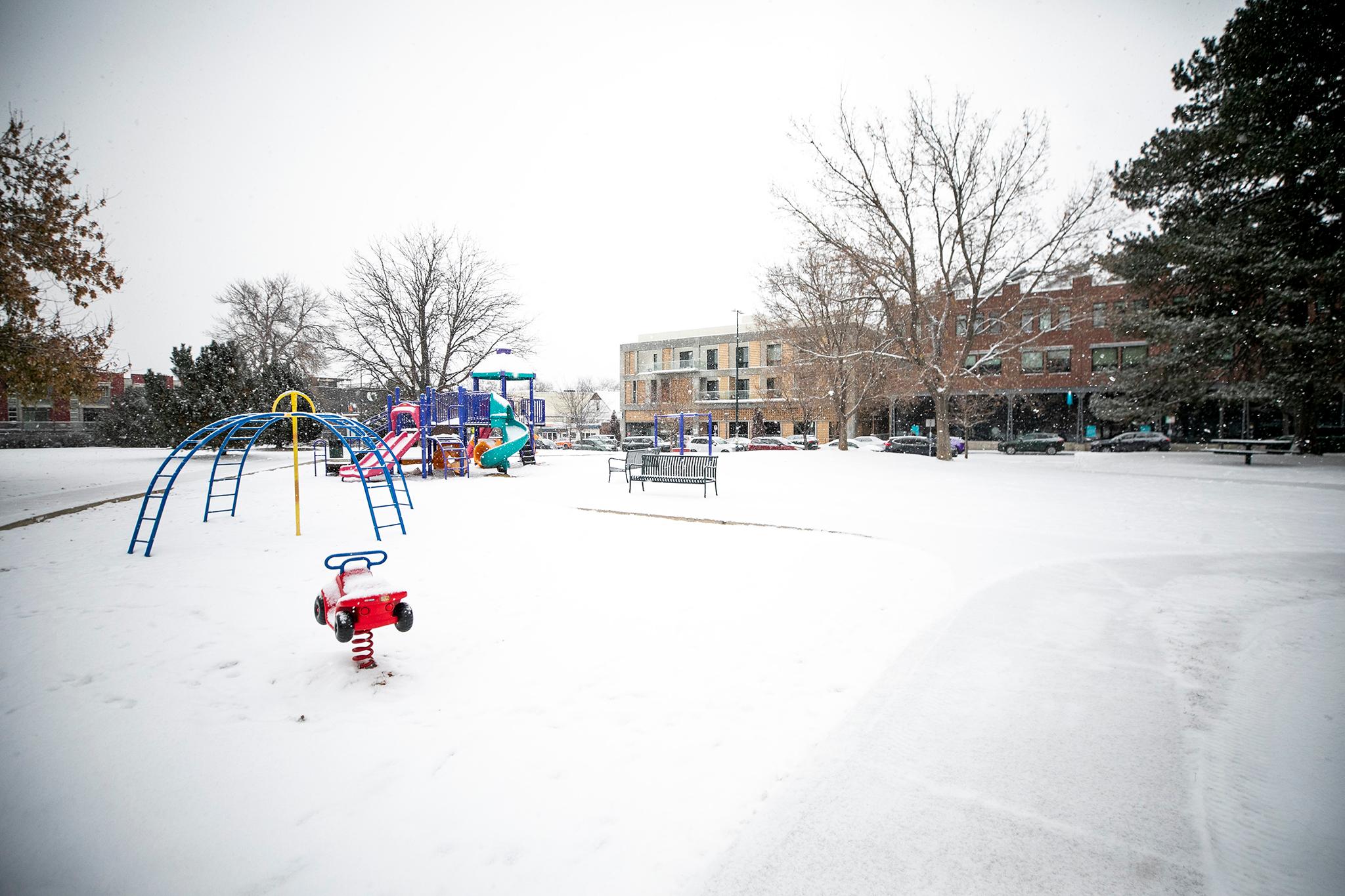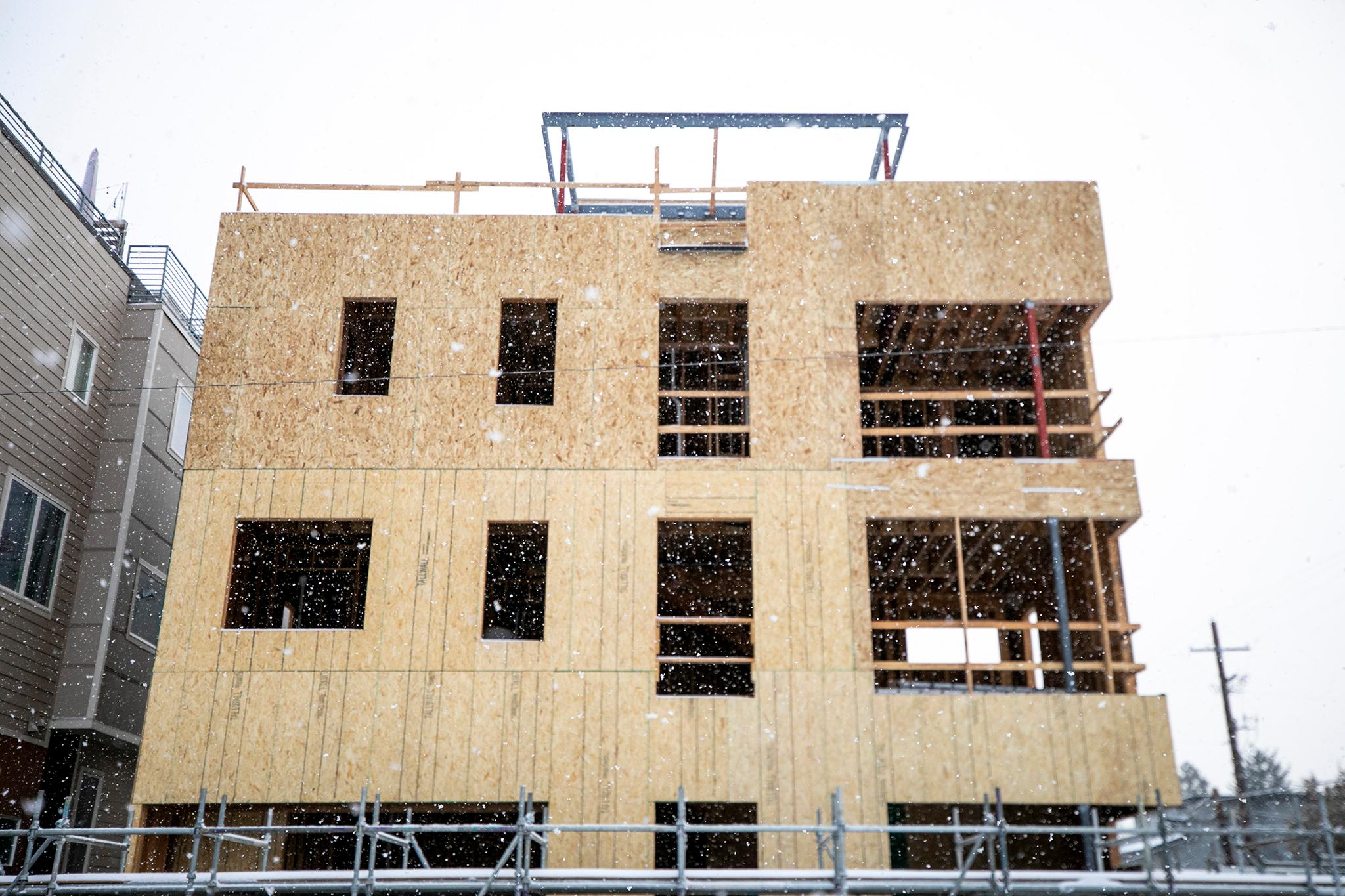This article is a part of Denverite's Street Week: Tennyson series. We're exploring the area by way of the history, people, carp-filled lakes and weird houses that define it. Read more Tennyson stories here.

Nestled between homes and businesses on a commercial strip of Tennyson Street is a large swath of green space that features a playground, public art and an open field.
That's César Chávez Park, an oasis where on any given weekend a party is taking place, complete with music blaring and laughter ringing out. But the park wasn't always that green, nor was it always named after César Chávez, the iconic labor activist who, along with Dolores Huertas, created the National Farm Workers Association.
The story behind the park is a tale of American writers, neighborhood uniformity and change, arson, and the movement to cement a hero's legacy.
In the late 1800s, when West 44th Avenue and the Town of North Denver became the Tennyson Street and Berkeley neighborhood we know today, there was a bit of an obsession with Louisa May Alcott, a feminist and active member of the women's suffrage movement, as well as the author of "Little Women."
With Berkeley growing, an educational institution was needed. Thus on the corner of 41st Avenue and Tennyson in 1893, a four-classroom school was built and named after Alcott by a member of the board of education.
"Named in her honor whereby it would educate the little men and little women of Berkeley," wrote historian Phil Goodstein in his book "North Side Story: Denver's Most Intriguing Neighborhood."
From there, the Alcott name became synonymous with the Berkeley neighborhood. The Berkeley Post Office became the Alcott Postal Station in 1896. There were a number of Alcott pharmacies and the Alcott Theatre opened in 1912.
Alcott Elementary was the neighborhood school until it was set to be demolished in 1976. The students would be transferred to the new Centennial Elementary at 47th Avenue and Raleigh Street.
The day before demolition, a fire destroyed the school.
Then fire chief Myrle Wise told the Denver Post that the fire was "an apparent arson," noting that there were two separate arson attempts on the building weeks prior.
The lot was turned into vacant greenspace and was colloquially called Alcott Park by nearby residents. In the early 2000s, Denver Parks and Recreation was ready to transform the space into a true park -- but it needed a name.
That's when Ramon Del Castillo stepped into the picture.
Del Castillo is a Chicano activist, and now-retired professor, who gravitated toward the movement during his time at the University of Northern Colorado because of his family's history. When his family immigrated from Mexico in the early 1900s, they became packing-house workers and he also followed suit.
The Labor Rights movement was important for Del Castillo, so during a student meeting when one member nominated him to lead Chávez's boycott efforts of lettuce production in Greeley, Del Castillo agreed.
Chávez later became a hero to Del Castillo and many other Chicanos and Mexican-Americans, especially across Denver and Colorado.
In 2001, former Denver Mayor Wellington Webb declared the last Monday in March as César Chávez Day, an observed city holiday. Earlier that year, Colorado declared Chávez's birthday, March 31, as an optional state holiday.
Also that same year, Del Castillo co-founded the César Chávez Peace and Justice Committee with the goal of educating folks on Chávez and his activism. The group also started a solidarity march in Chávez's honor in 2002.
But in 2004, Del Castillo said the group wanted something more.
"I always had the vision that we needed to create a legacy because when I took Mexican American studies, there were no Mexican American heroes. Schools didn't tout them," Del Castillo said. "For too long, our people haven't had heroes and heroines in the communities that we can look up to. We've always had to either not have any or adopt the white man's heroes. And I say that with respect, not pejoratively, but that was how it was with us ... So, we had decided to look for something more, something to institutionalize [Chávez's legacy]."
When Del Castillo searched for a way to increase Chávez's reach across the city, a council member mentioned that a park on Tennyson Street was about to be renovated and had no official name.
Del Castillo said the peace committee jumped on the idea, gathering signatures and hosting community meetings.

There was pushback. Many nearby residents were in favor of naming the park after Chávez but some believed it should be named after Alcott. After all, it was a historic name in the neighborhood. Del Castillo said many didn't understand the relevance in naming the park after Chávez because he had no official ties to the park, Tennyson or the Berkeley neighborhood.
But Del Castillo said that wasn't true.
The Northside, which includes Berkeley, has a long history of being a predominantly Latino area. Although the early 2000s was the beginning of gentrification in the area, working-class people still existed.
And bottom line, Del Castillo thought, why couldn't Chicanos, Mexicans and Latinos see a piece of city land named after an influential leader that resembled them?
"There's still working-class people that have the right to have their heroes listed in books and in public spaces," Del Castillo said. "When I went to school, I never, ever, ever, ever, ever, ever, ever saw a book with a Spanish surname on it. It always stuck with me. Why? Do we have people that write? This was our attempt to provide equity to all the kids. So, they can know that there's leaders in all kinds of groups that did a lot for humanity."
In 2005, the unofficially named Alcott Park became known as César Chávez Park. Del Castillo said the yearly marches began ending at the park, where folks would gather to celebrate Chávez.
But as the years passed, the Peace Committee felt that one more piece was needed to solidify Chávez's legacy in the city. That's when Del Castillo thought of adding a bust.
The group started raising money to have a sculpture made in Chávez's likeness, commissioning Emanuel Martinez, a Chicano artist with murals all around Denver and several pieces of art in the Smithsonian American Art Museum, two of which honor Chávez.
The bust was donated to the city by the Peace Committee, and installed in 2015.
Now, it's the centerpiece of the park and the annual Chávez marches.
"That bust is a piece of iconography that we hope stays there," Del Castillo said.

It's a wish that comes as Tennyson Street continues to see changes. It has changed since the days of Alcott Elementary and will continue to do so as the commercial strip and neighborhood becomes more desirable to higher-income residents, leading to more gentrification.
The Northside, as a whole, is also a part of that wheel of change, leading to high levels of displacement of the Latinos and Chicanos who called the area home.
Del Castillo hopes that whoever ends up living near the park looks into Chávez and learns about his history. He may be a Chicano leader and hero but that activism spreads to all races and people.
"Chávez was a very honorable person with real strong values about family, about social justice, about equity," Del Castillo said. "There's not a lot of raza there anymore because it's been gentrified, but the spirit is there and we hope that through that spirit people realize who this man was and what he did for humanity."













